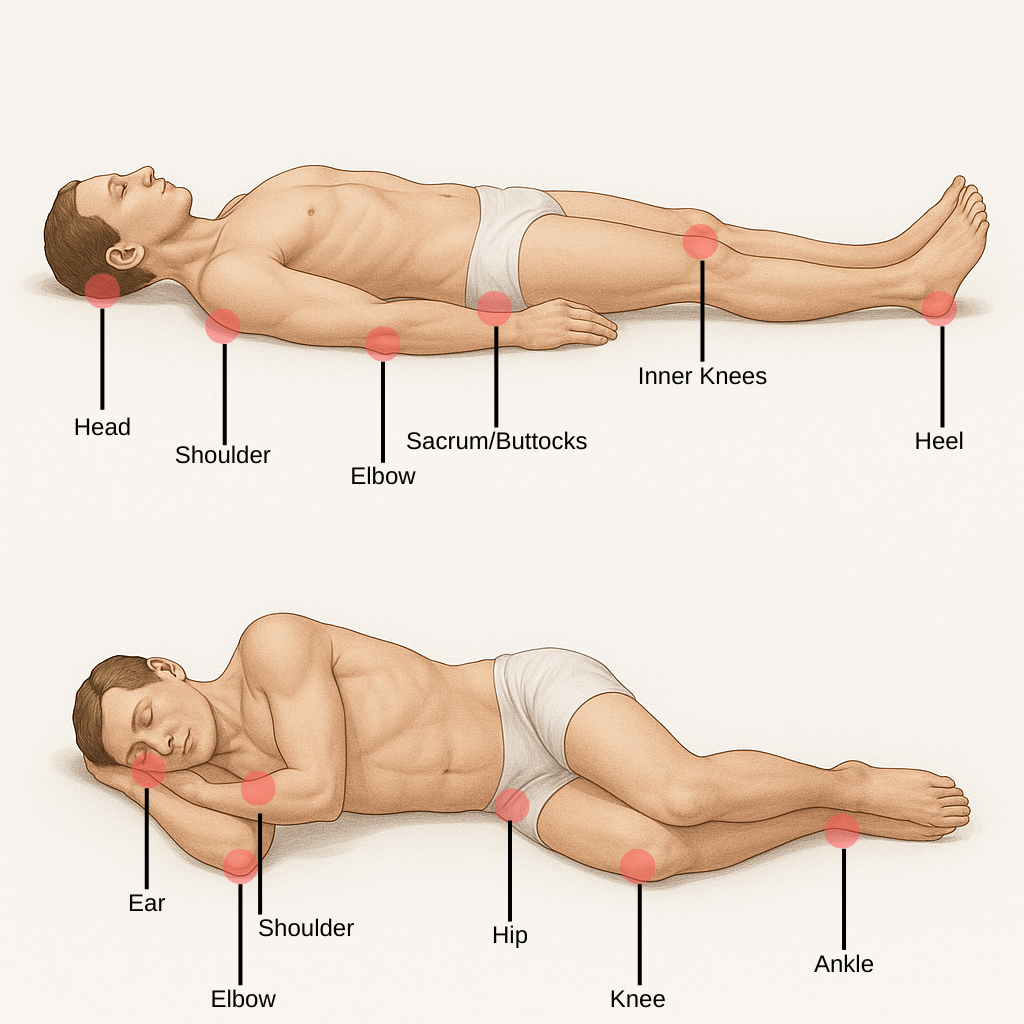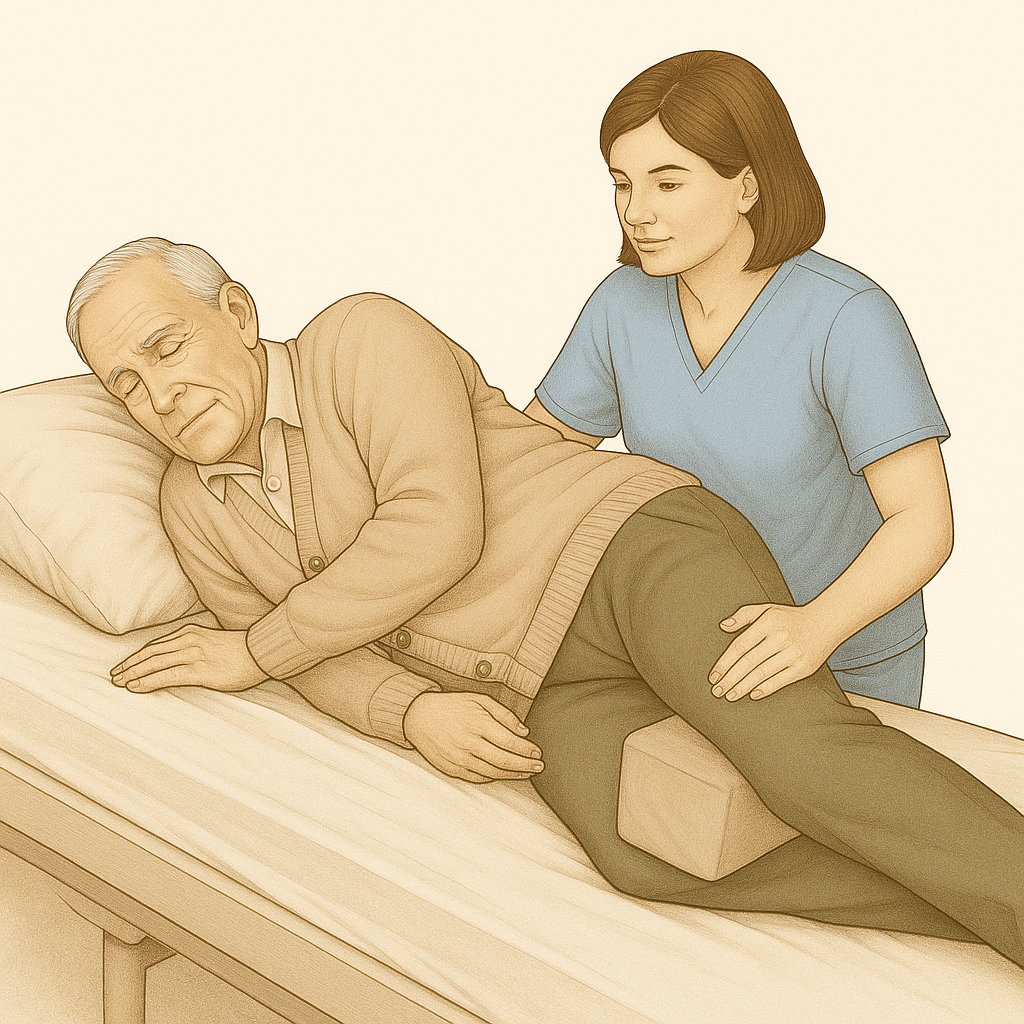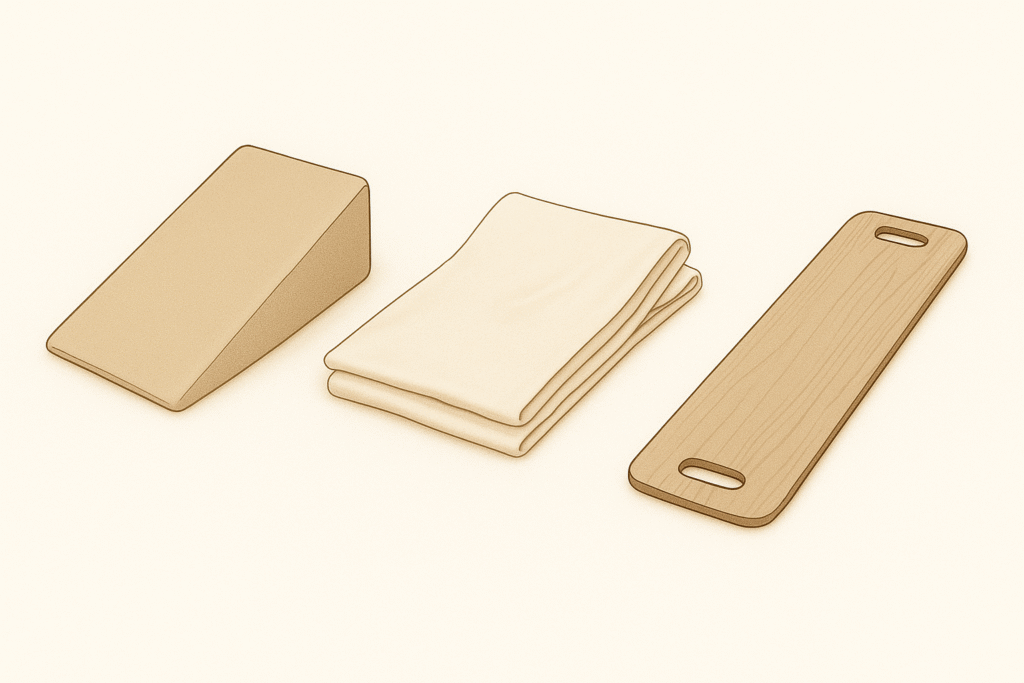Introduction
For seniors who spend extended time in bed, regular repositioning is one of the most effective ways to protect health and comfort. Proper positioning reduces the risk of pressure ulcers, improves circulation, supports breathing, and eases muscle stiffness.
For caregivers, knowing how to safely reposition seniors in bed is essential — both to protect your loved one and to protect your own body from injury. With the right approach, repositioning doesn’t have to feel overwhelming. This guide outlines the importance of repositioning, recommended techniques, and practical tools that make the process safer and more effective.
Disclaimer: This information is for educational purposes only and is not a substitute for medical advice. Always follow your healthcare provider’s recommendations, especially if the senior has medical restrictions or mobility limitations.
Why Regular Repositioning Is Essential
Without movement, prolonged pressure on the skin and underlying tissue can quickly lead to complications. Some of the most important benefits of repositioning include:
- Pressure ulcer prevention: Offloads bony areas like the sacrum, heels, hips, and shoulders.
- Improved circulation and breathing: Changing positions allows better airflow and reduces stiffness.
- Comfort and rest: Shifting positions reduces aches, pain, and discomfort from lying in one position too long.
- Reduced complications: Decreases the risk of skin breakdown, contractures, and pneumonia.

Each year, more than 2.5 million people in the United States develop pressure ulcers, according to the Agency for Healthcare Research and Quality (AHRQ).
For seniors who already spend long hours seated, using the right wheelchair cushion can add extra protection against pressure points — see our best wheelchair cushions for seniors (2025 review).
How Often Should You Reposition?
- Standard recommendation: At least every 2 hours when in bed, and every 15–30 minutes when seated in a wheelchair (as tolerated).
- Individualized schedules: Adjust frequency based on the senior’s health status, skin condition, and doctor’s orders.
- Clinical judgment matters: A frail, immobile patient may need more frequent adjustments than a relatively active senior.
If your loved one also uses a walker or rollator for mobility between bed and chair, make sure they have the right support — our guide to the best walkers & rollators for seniors (2025) covers safe options.
Preparing to Reposition Safely
Before repositioning:
- Communicate: Explain each step to the senior, even if they have limited cognition — it reduces anxiety and builds trust.
- Hand hygiene: Wash your hands thoroughly before and after repositioning to protect both you and the senior from infection.
- Gather supplies: pillows, foam wedges, draw/slide sheet, and barrier cream if incontinence is an issue.
- Set the environment: Adjust the bed height to protect your own back and remove obstacles such as cords or trays.
Step-by-Step Repositioning Techniques
Supine to Side-Lying (Most Common)

- Use a draw sheet under the senior’s torso.
- Gently roll or shift toward the side, keeping the spine aligned.
- Position two wedges on the same side: one behind the back, one under the posterior thigh/buttock. Keep a small gap at the sacrum.
- Support the head, arms, and knees with pillows as needed.
The 30-Degree Tilt (Preferred for Pressure Ulcer Prevention)
- Instead of rolling fully onto the side, tilt the body at about 30 degrees.
- The senior’s back is gently angled, with wedges holding them in place.
- This reduces direct pressure on the hips and sacrum while maintaining spinal alignment.
This angled approach is recommended by wound care specialists as one of the most effective strategies to reduce pressure ulcer risk — see our full guide on how to prevent pressure ulcers in seniors.
While the side-lying and 30-degree tilt are most commonly recommended for pressure relief, other positions may occasionally be used depending on comfort, medical needs, or breathing support. These positions are less common but can still play a role in specific situations.
Other Positions
- Semi-Fowler’s (30–45° upright): Improves breathing but increases sacral pressure — use sparingly.
- Prone (lying on stomach): Rarely used in elderly patients outside of hospital settings.
Using Positioning Aids
- Foam wedges: Maintain angle better than pillows and reduce slipping.
- Slide sheets or transfer boards: Reduce friction and protect skin.
- Specialty mattresses: Alternating pressure mattresses or overlays reduce risk further.
- Bed rails: Can assist with stability, but ensure they meet safety standards to prevent entrapment.
Foam wedges, slide sheets, specialty mattresses, and bed rails are common tools for safe repositioning. For seniors who spend significant time in wheelchairs, specialized wheelchair cushions also play an important role in relieving pressure and protecting skin.

Safety Tips for Caregivers
- Protect yourself: Bend your knees, not your back, and use a wide stance.
- Never work alone if unsafe: Ask for help if the senior is heavy, resists movement, or you feel strain.
- Avoid dragging: Always lift slightly or use a draw sheet to prevent shearing injuries.
- Monitor comfort: Reposition gently and watch for grimacing, pain, or distress.
- Check skin every time: Look for redness, moisture, or early signs of pressure injury.
When to Seek Professional Help
Contact the healthcare team if:
- You notice skin breakdown that isn’t improving.
- The senior reports significant pain during repositioning.
- You cannot safely move the patient without risking injury.
- You need training in using lifts or advanced positioning equipment.
Conclusion
Repositioning may feel like a simple task, but it is one of the most powerful ways to protect a senior’s health and quality of life. By learning how to safely reposition seniors in bed, caregivers can prevent pressure ulcers, improve comfort, and reduce serious complications. Small, consistent actions — every few hours — make the biggest difference.
Safe repositioning works best when combined with mobility strategies outside of bed.
If walking is an option, consider lightweight support devices — our best walkers & rollators for seniors (2025 guide) may be helpful.
For caregivers, learning these simple repositioning strategies not only protects your loved one’s health but also gives you confidence and peace of mind in daily care.
Disclaimer
This guide is for educational purposes only. Always follow professional medical guidance and check with a healthcare provider before attempting repositioning, especially if the senior has medical restrictions or is at risk of falls.
